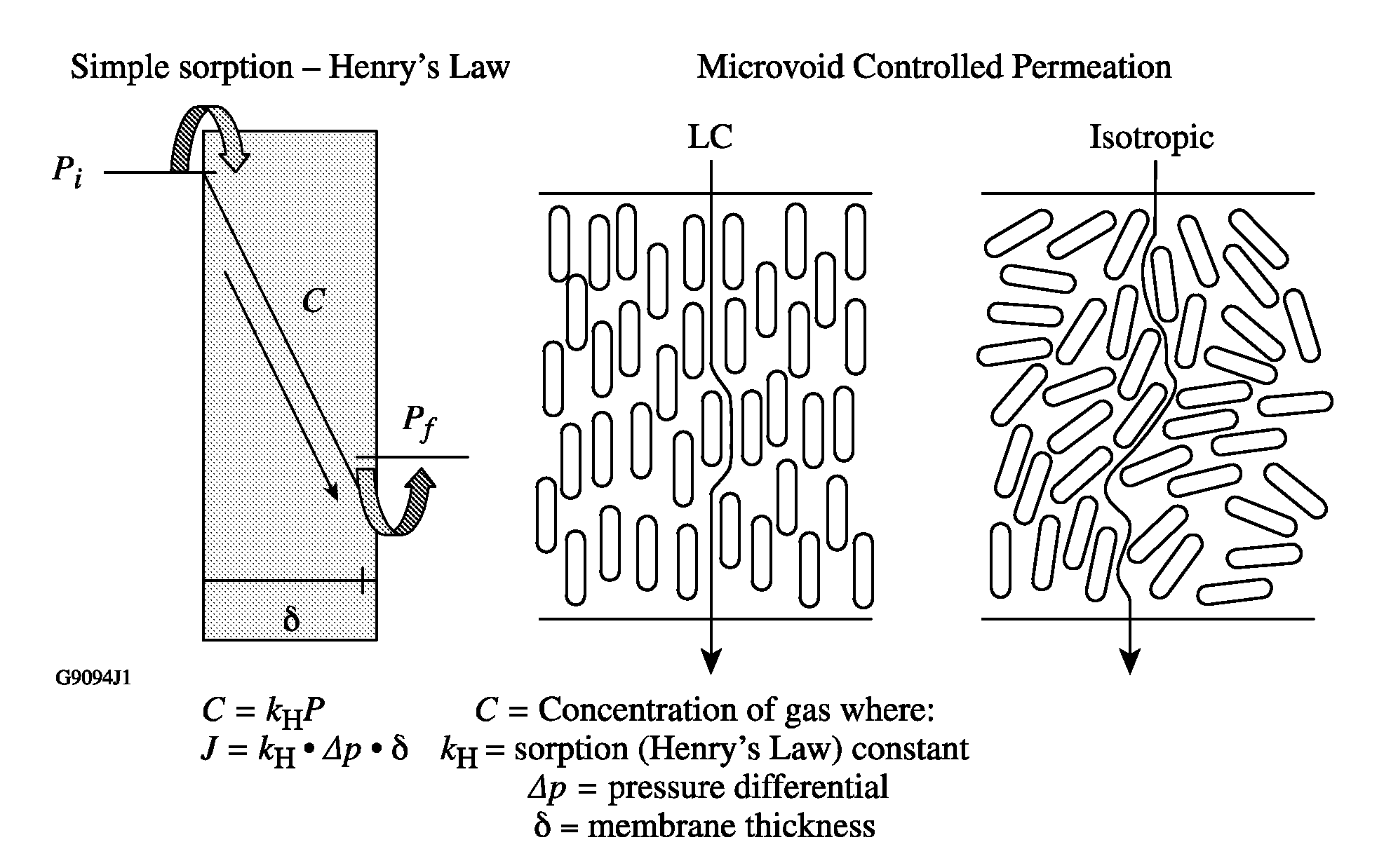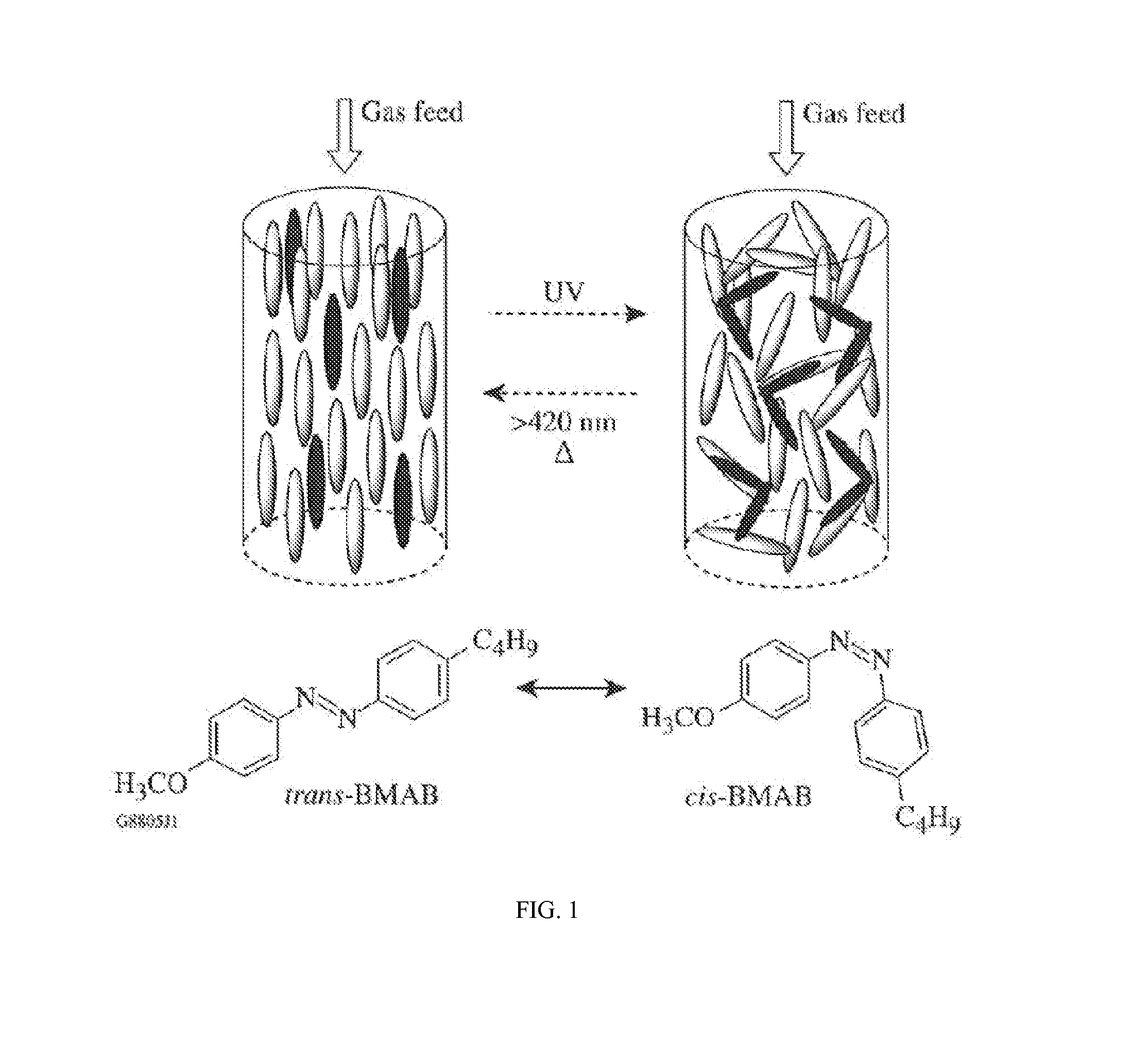Photo-switchable membrane and method
a technology of photo-switchable membrane and switchable gas, which is applied in the direction of separation process, dispersed particle separation, chemistry apparatus and process, etc., can solve the problems of unattractive absorption-adsorption method, energy-intensive cryogenic method, thermal and other directions
- Summary
- Abstract
- Description
- Claims
- Application Information
AI Technical Summary
Benefits of technology
Problems solved by technology
Method used
Image
Examples
example 1
[0037]In the first example, below, the optical, thermal, and orientational properties of the confined LC eutectics are characterized and their basic permeation qualities are evaluated. The reversible permeation control of nitrogen gas is also demonstrated.
[0038]To generate phase changes isothermally, the inventors used photochromic dyes that demonstrate a photomechanical effect. Azobenzene derivatives are photochromic dyes that convert incident light to mechanical energy through the process of trans-cis isomerization. Appropriate substitution at the para positions affords azobenzene derivatives, where the trans form is mesogenic because of its rod-like shape. In contrast, the cis isomer's bent shape substantially perturbs LC ordering. This effect is illustrated in FIG. 1.
[0039]Several demonstrations of bulk nematic-to isotropic-phase changes induced by trans-cis photoisomerization in azobenzenes have been conducted in both low-molar-mass and polymeric systems. This “photomechanical”...
example 2
[0062]In this work are described further studies to answer basic questions about how gases permeate through LC media by means of variable pressure, constant volume permeation analysis of imbibed LC materials containing azobenzene dyes, either dissolved as components of a host mixture or chemically functionalized as pendant groups to a polymerizable LC material.
[0063]Stimuli-responsive gas permeation membranes hold substantial potential for industrial processes as well as in analytical and screening applications. Such “smart” membrane systems, although prevalent in liquid mass-transfer manipulations, have yet to be realized for gas applications. Progress toward developing gas permeation membranes in which liquid crystalline (LC) phases afford the active region of permeation is reported below. To achieve rapid and reversible switching between LC and isotropic permeation states, the photomechanical action of mesogenic azobenzene dyes that can produce isothermal nematic-isotropic transi...
examples 1 and 2
METHODS AND MATERIALS
[0071]1. Preparation of Photo-Switchable LC Mixtures
[0072]Photo-switchable eutectic mixtures were prepared by adding an azobenzene LC material to an existing eutectic LC mixture and mixing above the isotropic temperature of the mixture. The phase transition of the mixtures was verified by hot-stage polarizing microscopy (POM). Eutectic 1 was prepared by doping 14% w / w of the azobenzene 4-butyl-4′-methoxyazobenzene (BMAB) into the biphenyl host Merck E7 at elevated temperature (where the Merck E7 is a mixture comprising approximately 51 wt % of 4-cyano-4′-n-pentylbiphenyl (“5CB”); approximately 25 wt % of 4-cyano-4′-n-heptyl biphenyl (“7CB”); approximately 16 wt % of 4-cyano-4′-n-oxyoctylbiphenyl (“8OCB”); and approximately 8 wt % of 4-cyano-4″-n-pentyl-p-terphenyl (“5CT”)). It should be noted that while Merck E7 was used for certain experiments herein, other biphenyl hosts are possible. The azobenzene compound was synthesized, as previously reported. Eutectic 2 ...
PUM
| Property | Measurement | Unit |
|---|---|---|
| thickness | aaaaa | aaaaa |
| pressures | aaaaa | aaaaa |
| permeability | aaaaa | aaaaa |
Abstract
Description
Claims
Application Information
 Login to View More
Login to View More - R&D
- Intellectual Property
- Life Sciences
- Materials
- Tech Scout
- Unparalleled Data Quality
- Higher Quality Content
- 60% Fewer Hallucinations
Browse by: Latest US Patents, China's latest patents, Technical Efficacy Thesaurus, Application Domain, Technology Topic, Popular Technical Reports.
© 2025 PatSnap. All rights reserved.Legal|Privacy policy|Modern Slavery Act Transparency Statement|Sitemap|About US| Contact US: help@patsnap.com



